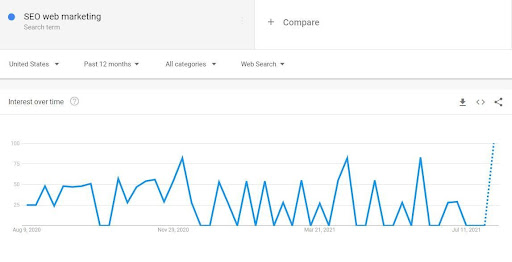7 Ways to Use Google Trends for Content Marketing
Digital businesses want to know what information people are searching for online. Better insights about popular keywords, terms and web user demographics can help businesses improve their marketing strategy.
Information about trends of search patterns help businesses to design content that helps users more effectively. It also gives them an opportunity to show how their products and services help people.
Let's take a closer look at how Google Trends can be used to create better content that gets noticed and brings traffic to your website.
What Is Google Trends?
Google Trends is a free, online tool from Google that can be used to find out the kind of information that people are searching for online. This tool presents the data in a visualized format for trending topics, search terms, and current news.

You can use it to further refine your search based on the region and time of search. The tool provides real-time data for current trends from the past seven days, all the way up to 2004 if you want.
It also shows keywords and terms that may be relevant to your search criteria.
Ways to Use Google Trends
Google Trends can be used in many ways to find out information about your industry, competitors, business, products and services. Here are some tips for using Google Trends that can take your SEO marketing to the next level.
Get New Content Ideas
The most obvious benefit of Google Trends is that it helps you focus on creating the right content for your website and digital assets.
The tool will show you the keywords that people are actively searching for in your area. This information can be shared with your content writer to produce relevant content, with trending keywords, and raise your search engine ranking.
Identify Seasonal Trends and Match Your Content Accordingly
Every industry from food businesses and retail to tourism, real estate and healthcare is affected by seasonal sales patterns. Online consumers tend to search for certain products and services more during certain times of the year.
Google Trends can be used to gain keen insight about these seasonal fluctuations in your sector. You can use that knowledge to create more effective sales strategies for the whole year.
Measure the Geographic Demand
Research shows that almost 80% of Google users search for local information. They try to find everything from the local weather to the nearest dining place online.
Many consumers search for local schools, hospitals, banks, insurance companies and clothing or fashion retailers that are close to home and open for business.
You can use this data to find out the local demand for your products and services. The data can be used to run targeted campaigns that raise your website's ranking for local searches.
Get Product Innovation Ideas
Google Trends can give you a good idea about the kind of product innovation that your customers want. Many product designers have started using it to identify the key features and specifications that they should include in their next upgrade.
For example, you can find out about the kind of product colors, design, style and materials that people are searching for online.
There is a section in the trend report that shows the 'Related Searches' to your keyword. The ones that are marked with Breakout show a growing ratio of searches from previous periods.
Use Trends for Topic Clustering
Topic clusters are used to create groups of related content that cover a much broader subject area. Google uses these clusters to build contextual support for all the web pages of a website into a group.
Experts say that topic clustering is a very effective way to create content that is focused on SEO. Google Trends can be used to identify the specific topics that people are searching for, and then create a cluster of content for it to help raise your website ranking.
Research Your Competitors
There is stiff competition in the world of SEO and organic ranking. Chances are that you are not the only business that is actively trying to improve your score. Your competitors may be using multiple strategies to get people talking about their brand, products and services.
You can use Google Trends to identify how your competitors are doing in terms of local area searches. You can also compare results for your brand with your competitors to get a better idea of where you stand.
Capitalize on the News and Current Affairs
Google trends can give you a good idea about what news and current affairs get the most public attention. You can use this for your brand promotion by creating content that revolves around popular current affairs.
For example, you may have noticed how advertisers adjust their TV commercials and make them all about football during the NFL season. They start using football players in ads and change the theme of their TVCs to all things related to football. We see something similar happen during the Olympic Games and FIFA World Cup.
What marketers do is that they take news topics that interest people, such as sports, and then create sports themed ads to attract viewers.
You can do the same by creating new content that is based on current and popular events.
Conclusion
Google Trends was not created for SEO or marketing purposes. The data collection system was originally designed to keep track of news items and help journalists see how different news stories develop over time.
However, the trend recording tool offers a lot of utility for online businesses that are looking to optimize their digital footprint. It can be an incredibly useful tool for businesses and content writing services to identify what people are searching for online.
Google Trends can help you identify the timeline for search phrases, location of geographical trends and related search terms to improve your overall content marketing strategy.
As a Sr. Editor, This guest article was written by Steven Dean, senior editor at Content Development Pros, experts at creating SEO-optimized content for small, midsize and large businesses. They offer blog writing services, content writing service and perform analyses of your marketing plan, your industry-specific needs, the platforms you want to rank on, as well as what your vision is for your organization before they create tailored SEO plans and content.


